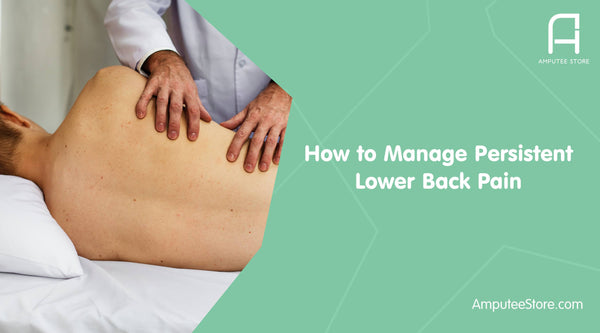How to Manage Persistent Lower Back Pain
Your body undergoes many complex changes after lower limb amputation, in part because it now has to reconfigure and reprogram itself to perform once subconscious movements, like walking. Numerous muscles are reutilized post-surgery, and this change is what ultimately creates an astonishing statistic reported by the Archives of Physical Medicine and Rehabilitation: 52% to 89.6% of lower limb amputees experience lower back pain.

This is not to say that an amputation guarantees low back pain. It's possible that it existed before amputation surgery and now made worse as a prosthetic user. Or laying in bed for too long post-surgery led to muscle weakness and subsequent low back pain. Regardless, more than half of amputees encounter lower back pain during their initial rehabilitation phase, as they begin to weight bear on their temporary prostheses.
It can be said that lower back pain is more impairing for many than the amputation itself.
This article delves into lower back pain to better understand its causes and possible preventative measures you can start today.
Causes of lower back pain
As mentioned earlier, prosthetic users may be at a higher risk for lower back pain for reasons that the general population isn’t exposed to.
Poor socket fit and poor prosthetic alignment
Since childhood, your mind and body has been performing the same specific sequence of movements necessary to walk. Learning how-to walk with a prosthetic leg alters years worth of "programming."
When beginning to walk with a prosthetic leg, socket fit and alignment are critical. If either is incorrect, many will over compensate and develop poor habits and secondary unnatural movements. These poor habits or compensatory movements can lead to lower back pain. Maintaining a prosthetic maintenance schedule, especially during early rehabilitation is really important. Early misalignments, fitting issues and poor sock management issues can be resolved when a schedule is kept.
Too often prosthetic users will rely too heavily on their sound side, by either limiting how much weight they drive through their prosthesis or using their prosthesis as a pseudo crutch. Walking in a "protected" fashion for reasons of distrust or skin irritation forces the body to utilize muscles in an unnatural way, adding stress to one's joints.
There is evidence from a 2005 study mentioned in the Archives of physical medicine and rehabilitation that not being able to wear your prosthesis can lead to a reduced quality of life. Thereby, potentially increasing the risk of depression and further affecting lower back pain.
Wearing a prosthesis that is well maintained from an alignment and fitting perspective, in contrast, can reduce chances of lower back pain. However, further studies are necessary that look directly at the effect of prosthetic alignment and its influence on chronic lower back pain.
Postural and muscle imbalances
Muscles imbalances, including muscle strength and length, have been documented in amputees by Physical Therapists and Prosthetists. Amputees experiencing prosthetic side weakness or tight muscles create compensatory movements with each step. This is very common in above-knee amputees who walk using a prosthesis with an improper degree of socket flexion, causing an exaggerated arching of the lower back.
Leg-length discrepancy
A leg length discrepancy from either a prosthesis that is too short, poor suspension, or improper sock ply count, directly affects the lower back. All it takes is a quarter inch difference in height for you begin feeling lower back pain after walking an hour.
Chronic Pain
Pain that lasts at least three months is considered chronic and is typically associated with surgeries that involve transecting nerves. Today a long-term multidisciplinary approach to chronic pain is suggested to lessen its influence on how you walk and any associated compensatory movements.
Lower Back Pain Management
There's little evidence or studies comparing the following treatments for lower back pain. However, it is clear that a lot of the issues that lead to lower back pain can be overcome with these treatments.
Exercise and Stretching
Leading a sedentary lifestyle causes muscle weakness and is linked to lower back pain. When your abdominal muscles are weak, this can cause weak hip flexors and lower back pain by encouraging a forward-leaning posture. We can't stress enough strengthening your core muscles.
Tight hamstrings, the large muscle group along the back of your leg, can restrict motion of your pelvis and cause chronic lower back pain for those wearing a below-knee prosthetic leg.
Tight hip flexors make it really difficult to control a flexed prosthetic knee for above-knee prosthetic users. Restricted hip extension related to tight hip flexors reduces the available range of motion to extend your hip and subsequently cause the prosthetic knee to extend.
Acupuncture
Acupuncture has been found to effectively treat lower back pain when compared to using no treatment. The ideal treatment would involve both acupuncture as well as another intervention such as adjusting your prosthetic alignment or correcting a leg length discrepancy.
In Summary
A multi-prong approach that includes education, physical activity and specific exercises and stretches in conjunction with acupuncture may be the most appropriate treatment for lower back pain. Directly addressing weak abdominals and deconditioning from a sedentary lifestyle, along with swimming will lead to improved lower back health.
Do you experience lower back pain? Please leave a comment below.










































































